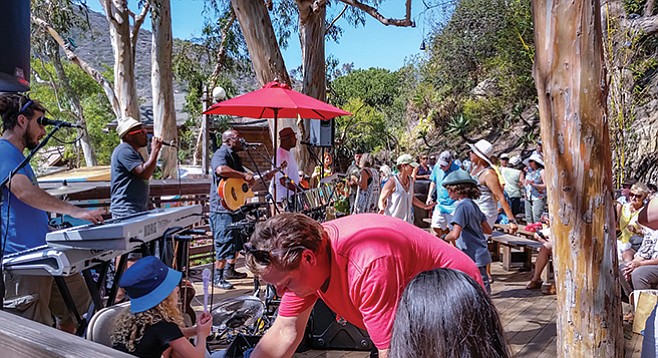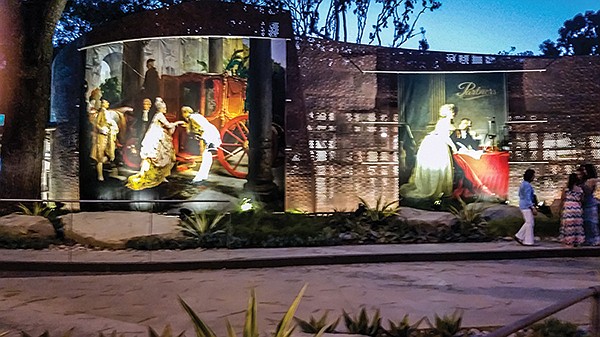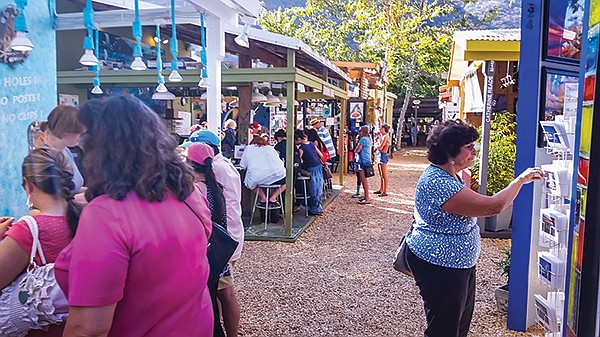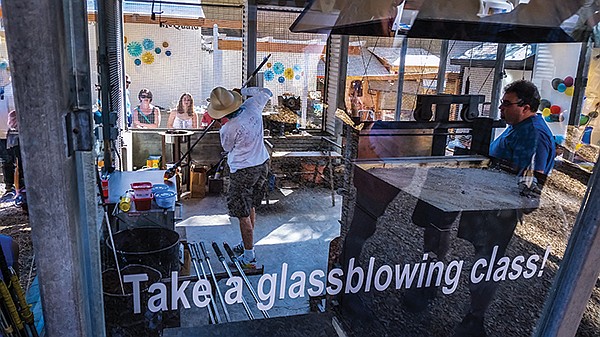 Facebook
Facebook
 X
X
 Instagram
Instagram
 TikTok
TikTok
 Youtube
Youtube

One does not simply accompany their mother to an arts festival in Orange County without reverting to a cynical state of adolescence, while at the same time joining in the postmodern chuckle of it all. That sentence is utter shit, but that didn’t stop me from taking it as a fundamental truth from which I would scrutinize and ultimately succumb to Laguna Beach’s seaside art scene in July.

While San Diego donned costumes for Comic-Con, I accompanied Mom on her yearly pilgrimage to the Pageant of the Masters, a 90-minute living re-creation of classic and contemporary works actualized by “hundreds of dedicated volunteers.” We redeemed some gift cards for dinner at P.F. Chang’s in the Irvine Spectrum consumerplex and, the next morning, headed west to pre-game for the pageant at a craft fair. Armed with an art-history-major girlfriend and a self-righteous sense of general malaise (blame the nasty Chang-over), I set off into the Sawdust Artfest Fandango, or whatever it was called, to shamelessly mouth-breathe on the zeitgeist of beachfront upper-crustia.

Tucked in an arid coastal canyon amid wafts of eucalyptus, ocean air, and meatball tacos, middle-aged Anglo Saxons gyrated to a Bob Marley cover band. Hyper-saturated metallic beach prints and “ABSOLUTELY NO PHOTOGRAPHS” signs hung everywhere, betraying paranoia beneath the make-believe Bohemia.
Not unlike P.F. Chang’s, mediocrity seemed to be the guiding virtue at this suburban jubilee of vanilla expressions, which focused mainly on pop imagery, California beach lore, stolen Native American patterns, and disposable quaintcore kitsch. Which is fine. There’s apparently a pretty large market for it. And in a way, it’s the perfect aesthetic for Orange County. Every piece seemed eerily bent on assuring you that everything is fine, nothing exists but this sunset, and nothing will ever change. This is the daydream you’ve been working your entire life for. You have arrived.
“It’s the California Dream,” my girlfriend Brooklyn remarked on another sunset series, “sealed away behind resin. It’s safer in there, wrapped in plastic. Look how each piece is handmade, but they feel mass-produced. There’s nothing to differentiate one from the other.”

A few artists spackled copy-paste countenances of Salvador Dalí over what they presumed to be their more whimsical works, as if to say: “Hey, if this challenges your cookie-cutter retire-cation, don’t blame me — the surrealist did it!”
It seems the pageant has unwittingly designated appropriation as the central artistic ethos in Laguna Beach. Everything serves to precipitate the realization that fine art is just a fixture upon which those “in the know” get to hang their own deluded sense of socioeconomic identity, if only anyone was paying attention. Several of the exhibiting artists were asleep in their own booths by 4 p.m.
Around sunset, we filed into the Irvine Bowl, where the Pageant of the Masters had filled the 2600-person amphitheater to capacity. It was here that I finally surrendered to the spectacle. It was a whirlwind: not just distant masterpieces as the name implies, but living reproductions of Czech art nouveau perfume bottles, a series of posters and dance numbers based on the show tunes of Fred Astaire and Gene Kelly, breathtaking renditions of Diego Rivera’s Detroit Industry and (progressively enough) Frida’s On the Border, and the pageant’s enduring closer, Leonardo da Vinci’s The Last Supper. For all the underwhelming stupor of Laguna Beach’s pay-to-play art fairs, the pageant stood apart as something rare and chiseled and alive. It’s referential, but riveting.
In the end, Mom was right about the pageant, but I’m still going to need some convincing on Thomas Kinkade. I told you there would be cynicism.


One does not simply accompany their mother to an arts festival in Orange County without reverting to a cynical state of adolescence, while at the same time joining in the postmodern chuckle of it all. That sentence is utter shit, but that didn’t stop me from taking it as a fundamental truth from which I would scrutinize and ultimately succumb to Laguna Beach’s seaside art scene in July.

While San Diego donned costumes for Comic-Con, I accompanied Mom on her yearly pilgrimage to the Pageant of the Masters, a 90-minute living re-creation of classic and contemporary works actualized by “hundreds of dedicated volunteers.” We redeemed some gift cards for dinner at P.F. Chang’s in the Irvine Spectrum consumerplex and, the next morning, headed west to pre-game for the pageant at a craft fair. Armed with an art-history-major girlfriend and a self-righteous sense of general malaise (blame the nasty Chang-over), I set off into the Sawdust Artfest Fandango, or whatever it was called, to shamelessly mouth-breathe on the zeitgeist of beachfront upper-crustia.

Tucked in an arid coastal canyon amid wafts of eucalyptus, ocean air, and meatball tacos, middle-aged Anglo Saxons gyrated to a Bob Marley cover band. Hyper-saturated metallic beach prints and “ABSOLUTELY NO PHOTOGRAPHS” signs hung everywhere, betraying paranoia beneath the make-believe Bohemia.
Not unlike P.F. Chang’s, mediocrity seemed to be the guiding virtue at this suburban jubilee of vanilla expressions, which focused mainly on pop imagery, California beach lore, stolen Native American patterns, and disposable quaintcore kitsch. Which is fine. There’s apparently a pretty large market for it. And in a way, it’s the perfect aesthetic for Orange County. Every piece seemed eerily bent on assuring you that everything is fine, nothing exists but this sunset, and nothing will ever change. This is the daydream you’ve been working your entire life for. You have arrived.
“It’s the California Dream,” my girlfriend Brooklyn remarked on another sunset series, “sealed away behind resin. It’s safer in there, wrapped in plastic. Look how each piece is handmade, but they feel mass-produced. There’s nothing to differentiate one from the other.”

A few artists spackled copy-paste countenances of Salvador Dalí over what they presumed to be their more whimsical works, as if to say: “Hey, if this challenges your cookie-cutter retire-cation, don’t blame me — the surrealist did it!”
It seems the pageant has unwittingly designated appropriation as the central artistic ethos in Laguna Beach. Everything serves to precipitate the realization that fine art is just a fixture upon which those “in the know” get to hang their own deluded sense of socioeconomic identity, if only anyone was paying attention. Several of the exhibiting artists were asleep in their own booths by 4 p.m.
Around sunset, we filed into the Irvine Bowl, where the Pageant of the Masters had filled the 2600-person amphitheater to capacity. It was here that I finally surrendered to the spectacle. It was a whirlwind: not just distant masterpieces as the name implies, but living reproductions of Czech art nouveau perfume bottles, a series of posters and dance numbers based on the show tunes of Fred Astaire and Gene Kelly, breathtaking renditions of Diego Rivera’s Detroit Industry and (progressively enough) Frida’s On the Border, and the pageant’s enduring closer, Leonardo da Vinci’s The Last Supper. For all the underwhelming stupor of Laguna Beach’s pay-to-play art fairs, the pageant stood apart as something rare and chiseled and alive. It’s referential, but riveting.
In the end, Mom was right about the pageant, but I’m still going to need some convincing on Thomas Kinkade. I told you there would be cynicism.
Comments